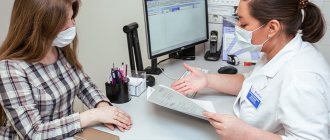Candidiasis (thrush) is a disease in which the skin, as well as the mucous membranes of the mouth and genitals, are affected by the yeast-like fungus Candida. It is classified as a conditionally pathogenic environment. This means that in small quantities such microorganisms inhabit the mucous membranes and skin of healthy people, and their growth is inhibited by the body’s immunity. But when it weakens, intensive proliferation of the fungus occurs, which leads to the development of thrush.
When treating this disease, it is important to choose the right medications based on the type of Candida fungus (there are over eighty of them). Otherwise, there is a high risk of developing a drug-resistant strain, which makes further treatment much more difficult.
The most common forms of the disease are oral (in infants and newborns) and vaginal (in women and men of various ages). This article will focus on vaginal candidiasis.
Causes
Factors that can trigger the development of candidiasis are conventionally divided into three categories:
- Exogenous factors - the environment facilitates the penetration of harmful
- microorganisms:
- increased levels of fungi in the air under production conditions;
- temperature conditions that cause excessive sweating;
- improperly observed hygiene regime.
- Endogenous factors – a decrease in the body’s resistance due to the occurrence of:
- vitamin deficiency;
- metabolic diseases such as obesity, dysproteinemia, ulcerative colitis, diabetes mellitus, dysbacteriosis;
- Itsenko-Cushing's disease;
- infectious chronic processes;
- vegetative dystonia with increased sweating;
- neoplasms;
- thyrotoxicosis;
- diseases of the blood system, etc.
Prevention of thrush
- Established proper nutrition, because intestinal dysbiosis, can subsequently provoke vaginal dysbiosis. The intestines can act as a reservoir for the causative agent of candidiasis.
- Correctly selected underwear.
- For personal hygiene of the genitals, you should use clean water or hygiene products with optimal pH; they will not disturb the vaginal flora.
- Taking antibiotics only as prescribed by a doctor and in combination with medications for the prevention of candidiasis, which will prevent its reproduction.
- Taking vitamin supplements to strengthen the immune system;
If chronic endocrine diseases are present, you should strictly follow all the doctor’s recommendations so as not to provoke hormonal imbalance.
Symptoms
Vaginal candidiasis is most common among women of reproductive age, but can also occur in girls, affecting the vagina and external genitalia, and even in men, the foreskin and head of the penis.
Symptoms of thrush in women:
- discomfort during sexual intercourse;
- swelling and redness of the mucous membranes of the genital organs;
- copious discharge of a cheesy consistency with a sour odor;
- burning and pain when urinating;
- itching that intensifies before or after menstruation, in the evening, with untimely hygiene, with hypothermia.
Symptoms of candidiasis in men:
- pain during sexual intercourse and urination;
- itching, redness, pain, formation of a white cheesy coating in the area of the head of the penis.
If you notice the above signs, you should immediately consult a doctor. “The ProfiMed polyclinic offers women to make an appointment with a gynecologist for a fee in Moscow, and men to use the services of a professional urologist.
The best creams for thrush
Such remedies are needed if it is necessary to urgently eliminate the symptoms of fungal infection of the mucous membranes, and they are used exclusively externally. There are quite a lot of creams on the market, but we chose the most effective and safe ones, based on customer reviews.
Clotrimazole
Cream "Clotrimazole" is intended to eliminate external symptoms of active activity of yeast-like fungi "Candida". It is recommended to buy it for both women and men. The composition includes biologically active components that guarantee quick results. It is a white, not very thick mass that spreads easily over the area of concern and leaves no traces after absorption.
Clotrimazole is easy to use, but it must be applied to dry and clean skin. The optimal frequency of such treatments is 2-3 times a day; the more often you lubricate the mucous membrane, the faster the effect will be visible. Doctors indicate that the substances from the cream are practically not absorbed into the bloodstream, which means that the risk of side effects is very low.
Advantages
- High concentration of active substance;
- Relatively natural composition;
- Good texture;
- Excellent consistency, does not spread;
- Economical consumption;
- Adequate smell;
- Quickly absorbed.
Flaws
- Doesn't squeeze out well from the tube.
According to customer reviews, Clotrimazole is the best remedy for thrush, in particular because it not only eliminates the symptoms of candidiasis, but also effectively fights the reasons why the disease developed.
Pimafucin
Among all the creams in the rating, this is the most universal remedy that effectively helps not only with lesions of the genital organs, but also copes with fungal diseases of the nails and skin. The wide spectrum of action is due to the presence of natamycin in the composition, to which almost all fungi are sensitive, except that it does not scare dermatophytes. Pimafucin is instantly absorbed into tissues and does not cause discomfort; it can also be combined with other drugs without any problems.
Advantages
- Volume – 30 g;
- Good texture;
- Easy to apply and spread;
- Does not stain laundry;
- The number of contraindications is not large;
- No pungent smell.
Flaws
- Up to 4 applications per day may be required if the disease is advanced.
For better penetration into tissues, before using Pimafucin, it is recommended to clean the skin of dirt and wipe dry.
Candide
The name of the product speaks for itself - it is used to treat candidiasis, and not only of the vaginal type. The cream is quite effective and safe, but under no circumstances should it be applied to areas with compromised skin integrity. The dermis normally tolerates the effects of Candida; the appearance of itching, burning, and swelling is possible only with individual sensitivity to the components in the formulation. On average, treatment is carried out for 2-4 weeks under the supervision of a doctor. A 20 g tube is usually not enough for one course.
Advantages
- Low price;
- No side effects;
- A large amount of clotrimazole in the composition;
- No thick layer required;
- There is no need to take long breaks between courses.
Flaws
- Contains benzyl alcohol;
- It is not advisable to use during pregnancy.
Candide cream acts directly on cells affected by the fungus and triggers the process of their lysis and then death. In the future, it may be used to prevent the recurrence of thrush.
Diagnostics
Diagnosis of vaginal candidiasis is carried out as follows:
- Microscopy of a smear test for thrush: a scraping is taken from the vaginal walls with a special swab onto a glass slide for further examination under a microscope. If there is an infection, Candida fungi will be present in the smear.
- Sowing - growing a culture of fungus from a smear scraping for analysis for thrush. Candidiasis is only diagnosed when fungal colonies grow to 10,000 CFU/ml, since in most women they are always present in the vagina.
- Determination of the type of Candida fungi and their sensitivity to medications.
Rating of the best remedies for thrush
Before inclusion in the TOP, all drugs were compared with each other according to the following parameters:
- Type – tablets, capsules, creams, suppositories;
- Sensitivity of various infections to components;
- Speed of action;
- Composition safety;
- No side effects;
- Number of contraindications;
- Taste and smell;
- Dimensions;
- Reception frequency;
- Duration of the course of therapy;
- Quick absorption or dissolution;
- Is a prescription required for purchase?
One of the key parameters was the price-quality ratio, the availability of drugs in pharmacies, and the ease of their use.
The best accurate pregnancy tests
Treatment
For mild cases of candidiasis in women, local treatment is used using vaginal suppositories or tablets, as well as antifungal creams:
- Clotrimazole (antifungol, canizon, candibene);
- Nystatin;
- Miconazole (Klion-D);
- Natamycin, etc.
Creams and suppositories cure thrush in a week, modern drugs - in one or two days. To fully guarantee recovery, the course of treatment is repeated twice. In some cases, a single dose of fluconazole (Mikomax, Diflucan, Forkan, Flucostat, etc.) is prescribed at a dosage of 150 mg orally.
When the infection recurs, treatment of candidiasis is aimed at relieving the symptoms of the disease and subsequent prevention. In addition to local treatment, oral medications are prescribed, which are selected individually for the specific type of Candida fungus. These are vaginal tablets and suppositories with clotrimazole, as well as taking flucanozole 100 mg orally - once a week for several months. It is also necessary to be examined regularly by a doctor.
To maintain immunity, it is recommended to increase the intake of bifidobacteria and limit irritating foods. During treatment you should abstain from sexual intercourse.
In most cases, the use of topical antifungal agents is enough to treat thrush for men. Your doctor will prescribe creams or ointments containing clotrimazole twice a day for a week. Additionally, general medications can be used if treatment is ineffective. Sexual contacts should be excluded during treatment.
It should be noted that with timely treatment, candidiasis cannot cause serious harm to health. But a long course of the disease can lead to damage to the kidneys, urethra and bladder, as well as to infertility. In particularly advanced forms, candidiasis has a damaging effect on the reproductive organs, which leads to male infertility.
Types of oral candidiasis and symptoms
The manifestations of oral candidiasis may vary between patients. This is due to the degree of damage to the mucous membranes, as well as the specific type of disease. There are four forms:
- acute pseudomembranous;
- acute atrophic;
- chronic atrophic;
- chronic hyperplastic.
Despite the fact that the treatment regimen for all forms is almost the same, the symptoms can differ significantly. Let's take a closer look at them.
Acute pseudomembranous candidiasis
This form of candidiasis of the oral mucosa can be asymptomatic. There is minor discomfort due to a white film or small plaques rising above the mucosa. With a mild course, one or several plaques appear; they are easily removed by scraping, and the area of the mucous membrane under them has a bright red color. In severe cases, large plaques appear in large numbers. They can merge, forming large affected areas. Sometimes symptoms cover the entire mucous membrane. When plaques thicken, their removal becomes problematic. A severe course is more typical for infants, as well as in adult patients after antibiotic therapy, corticosteroids, and immunosuppressants.
Acute and chronic atrophic candidiasis
Acute atrophic candidiasis is accompanied by a strong burning sensation. There may be no white plaque, and the mucous membrane becomes bright red. Many patients report a metallic, sour, salty or bitter taste in the mouth. A characteristic manifestation of the disease is dry mouth. This form of the disease is often associated with drug therapy.
With chronic atrophic candidiasis, redness and burning are less pronounced. Usually the disease develops against the background of the installation and wearing of prostheses.
Chronic hyperplastic candidiasis
This form of the disease is typical for adults. Oral thrush can spread to the mucous membranes of the cheeks, corners of the mouth and lips, back of the tongue, and soft palate. One of the symptoms is the appearance of white plaques that tend to merge with each other. As the disease progresses, their surface becomes rough and rough. Over time, the elements may turn yellow. The formations merge with the mucous membranes and cannot be removed.
List of used literature
Directory of medicines Compendium (Russian)
State Register of Medicines (Ukrainian)
How to treat thrush?
- Local preparations: vaginal suppositories, tablets, creams with econazole, clotrimazole, miconazole, natamycin.
- Systemic drugs: tablets, capsules with fluconazole (Difluzol, Diflucan, Fluconazole). For the treatment and prevention of intestinal candidiasis, Nystatin and Pimafucin are prescribed.
What causes thrush?
Thrush (candidiasis) is a disease caused by a fungus of the genus Candida, which is present in many human organs. The cause of thrush is the creation of a favorable environment for the yeast-like fungi Candida.
What to wash with when you have thrush?
You need to wash yourself with tar soap in the morning and evening. You can also use a baking soda solution. It is known that soda has an antimycotic effect, creating an alkaline environment that is destructive for fungi of the genus Candida. This reduces itching and irritation of the mucous membrane.







![Table 1. Comparison of the results of treatment with Tribestan for men with oligoasthenozoospermia [7] with mod.](https://ms-pi.ru/wp-content/uploads/tablica-1-sravnenie-rezultatov-lecheniya-tribestanom-muzhchin-s-oligoastenozoospermiej-7-330x140.jpg)